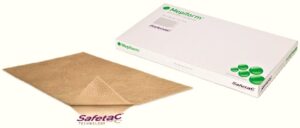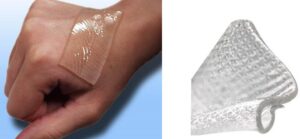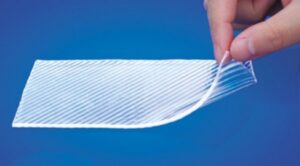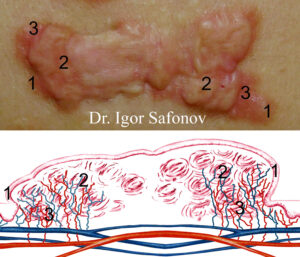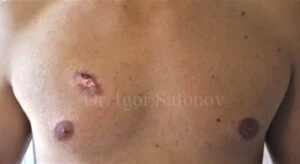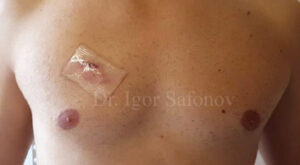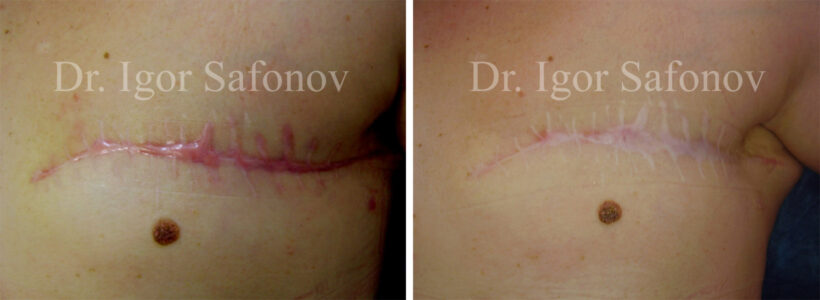What should I know before buying silicone sheets or silicone gel for scars treatment?
Silicone sheets, as well as silicone gel for treatment of scars are quite expensive. They might help somebody, somebody not. What you need to know before buying silicone sheets or scar gel? In what cases can the purchase of a scar gel or silicone sheets turn into a money loss? For the right choice of a silicone sheet or silicone gel we need to understand the way how they work on scars. This will be discussed below…
The main brands of silicone sheets in this market segment are Mepiform (Fig. 1), Cica Care (Fig. 2), Scar Fx » (Fig.3).
How does the silicone sheet work on a scar?
It is believed that the main action mechanism of the silicone sheet on a scar is the retention of water molecules in the scar tissue. In other words, the silicone sheet covers the scar and prevents water evaporation from its surface. By moistening the scar, connective tissue cells move faster, divide and exchange information through water more freely. As a result, a normotrophic scar is formed. Collagen fibers in such a scar are located parallel to the skin surface. All this is true if we are talking only about the usage of the silicone sheets to atrophic or normotrophic scars during their maturation.
Using of Mepiform silicone dressing. What happens in a scar?
Mepiform is a thin flexible dressing used for small scars after injuries, operations, abrasions and cuts. Mepiform should optimally be worn for 24 hours a day. During using time the silicone dressing creates a certain microenvironment in the scar area. This microenvironment provides good moisture and blood circulation for rapid cell division and collagen synthesis. As a result of the Mepiform silicone sheets usage an elastic normotrophic scar is formed.
Completely different to treat are the hypertrophic and keloid scars …
What happens in a keloid and in a hypertrophic scar?
The Mepiform silicone sheets are not suitable for the treatment and prevention of hypertrophic and keloid scars! And that’s why …
In pathological scars, other processes occur than in atrophic and normotrophic scars. In keloids, on the contrary, there is an increased division of cells and an uncontrolled increased collagen synthesis. Unlike normotrophic and atrophic scars, keloids are saturated with moisture (an edema is present). In order to grow, the keloid and hypertrophic scar must receive oxygen. And to get more oxygen, you need a more extensive network of blood vessels. To create this additional vascular network, the scar releases certain substances that stimulates the formation of new vessels. Growing keloids and hypertrophic scars are red because they constantly form new vessels (Fig. 4).
Now imagine what will happen if a thin Mepiform silicone sheet is applied to the surface of a keloid or a hypertrophic scar? At best, it won’t help! At worst, it will create a greenhouse effect and gives rise to even more swelling and further collagen synthesis increase.
Which silicone sheets are suitable best for keloids and hypertrophic scars?
The task is to compress the blood vessels that feed the scar for a long time. In this way, oxygen delivery to a keloid or to a hypertrophic scar can be blocked. When the blood vessels are compressed local ischemia and oxygen starvation occurs. If the supply of oxygen to the scar is sharply reduced or stops completely, the collagen synthesis also decreases (Fig. 5-6).
For the treatment of keloid and hypertrophic scars, it is advisable to use thick and heavy silicone sheets with a good adhesive base. Only such a silicone sheet will fit snugly against the skin and press the keloid or hypertrophic scar with its mass. The most common brands of such silicone dressings are: Scar Fx and Cica Care. The main substance that is part of silicone sheets is polyorganosiloxane (simplistically molten sand mixed with organic ingredients).
Due to prolonged ischemia (lack of oxygen), cells gradually slow down their division. As a result, collagen synthesis decreases, the scar turns pale, decrease in size and becomes more elastic (Fig. 7).

